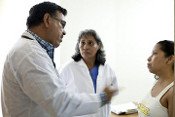Japan
Universal Health Coverage for Inclusive and Sustainable Development: Lessons from Japan
This report brings together 10 in-depth studies on different aspects of Japan’s UHC [Universal Healthcare Coverage] experience, using a common framework for analysis focused on the political economy of UHC reform, and the policies and strategies for addressing challenges in health financing and human resources for health. Japan’s commitment to UHC played a key role in the country’s economic recovery after World War second, and helped ensure that the benefits of economic growth were shared equitably across the population. [from abstract]
- 524 reads
Widening Disparity in the Geographic Distribution of Pediatricians in Japan
The purpose of this study was to investigate recent changes in the geographic distribution of pediatricians and the factors underlying this change. [from abstract]
- 634 reads
Impact of Japan's 2004 Postgraduate Training Program on Intra-Prefectural Distribution of Pediatricians in Japan
This study examined the trends in the geographic distribution of pediatricians as well as all physicians from 1996 to 2010 to identify the impact of the launch of a new training program for new medical graduates. [from abstract]
- 577 reads
Impact of Nurse Working Hours on Patient Safety Culture: A Cross-National Survey Including Japan, the United States and Chinese Taiwan Using the Hospital Survey on Patient Safety Culture
The purpose of this study was to clarify the impact of long nurse working hours on patient safety culture in Japan, the US, and Chinese Taiwan using the Hospital Survey on Patient Safety Culture assessment tool. [adapted from abstract]
- 918 reads
Characteristics of a Good Clinical Teacher as Perceived by Resident Physicians in Japan: A Qualitative Study
The objective of this study was to identify the characteristics of a good clinical teacher as perceived by resident physicians in Japan, a non-Western country, and to compare the results with those obtained in Western countries. [from abstract]
- 617 reads
Forecasting the Absolute and Relative Shortage of Physicians in Japan Using a System Dynamics Model Approach
The purpose of this study was to propose a physician supply forecasting methodology by applying system dynamics modeling to estimate future absolute and relative numbers of physicians. [from abstract]
- 572 reads
Nursing Leadership in a Rapidly Aging Society: Implications of the Future of Nursing Report in Japan
A recent report about the future of nursing highlights the areas where nurses can serve, contribute, and move forward to improve health care in the United States. The purpose of this paper demonstrate that the report’s recommendations could have implications for the future of nursing outside of the United States, particularly for nurses taking leadership in designing care for the rapidly aging society of Japan. [adapted from abstract]
- 741 reads
Exploring the Ideal Combination of Activity Satisfaction and Burden among Health Promotion Volunteers: A Cross-Sectional Study in Japan
The purposes of this study were to describe the prevalence of health promotion volunteers (HPVs) with differing levels of activity satisfaction and burden; examine the association between satisfaction and burden with activity involvement and persistence, and life satisfaction; and explore associated factors by satisfaction/burden levels among Japanese HPVs. [from abstract]
- 597 reads
Characteristics of Physicians, Their Migration Patterns and Distance: A Longitudinal Study in Hiroshima, Japan
The authors analyzed the flow of all the clinical physicians in Hiroshima Prefecture, Japan, with particular attention to migration to rural and distant places to determine effective workforce policies for rural and remote areas. [adapted from introduction]
- 663 reads
Measurement and Correlates of Empathy among Female Japanese Physicians
This study focused on female Japanese physicians and addressed factors that were associated with their empathic engagement in patient care. [from abstract]
- 777 reads
Does the Insufficient Supply of Physicians Worsen Their Urban-Rural Distribution? A Hiroshima-Nagasaki Comparison
Studies have suggested that a rapid increase in physicians does not necessarily change an urban–rural inequity in their distribution. This study applied spatial competition and attraction–repulsion hypotheses to the geographic distribution of physicians during a time of insufficient physician supply in Japan to determine whether an insufficient supply of physicians worsens an inequity. [adapted from abstract]
- 834 reads
Variation in Cancer Surgical Outcomes Associated with Physician and Nurse Staffing: A Retrospective Observational Study Using the Japanese Diagnosis Procedure Combination Database
This study aimed to investigate the association between cancer surgical outcomes and physician/nurse staffing in relation to hospital volume. [from abstract]
- 1025 reads
Urbanization and Physician Maldistribution: a Longitudinal Study in Japan
In this study, the authors analyze the trends in the geographic disparities of population and physician distribution among the secondary tier of medical care in Japan. [adapted from author]
- 1187 reads
Current Shortage and Future Surplus of Doctors: a Projection of the Future Growth of the Japanese Medical Workforce
The purpose of this research is to project the future growth of the Japanese medical doctor workforce from 2008 to 2050 and to forecast whether the proposed additional increase in the student quota will cause a doctor surplus. [from abstract]
- 1723 reads
Estimation of Physician Supply by Speciality and the Distribution Impact of Increasing Female Physcians in Japan
Japan has experienced two large changes which affect the supply and distribution of physicians. They are increases in medical school enrollment capacity and in the proportion of female physicians. The purpose of this study is to estimate the future supply of physicians by specialty and to predict the associated impact of increased female physicians, as well as to discuss the possible policy implications. [from abstract]
- 1529 reads
Systematic Inclusion of Mandatory Interprofessional Education in Health Professions Curricula at Gunma University: a Report of Student Self-Assessment in a Nine-Year Implementation
The mandatory interprofessional education program - a process by which students and practitioners from various health professions learn together with the goals of interaction and collaboration in providing health promotion, disease prevention, curative services, rehabilitation and palliation - was initiated in 1999 at Gunma University. This paper is a statistical evaluation of the programme from 1999 to 2007. [adapted from abstract]
- 2000 reads
Transition of Physician Distribution (1980–2002) in Japan and Factors Predicting Future Rural Practice
The maldistribution of physicians between urban and rural areas has long been an important political issue in Japan. The aim of this study was to evaluate long-term transition in the geographic distribution of physicians, and to reveal which rural physician characteristics predict their retention in rural areas. [adapted from abstract]
- 1718 reads
Distribution and Transitions of Physicians in Japan: a 1974-2004 Retrospective Cohort Study
This article presents the results of a study analyzing national trends in Japan regarding the distribution and career transitions of physicians among types of facilities and specialties over a 30-year period. [adapted from abstract]
- 1488 reads
Community Characteristics that Attract Physicians in Japan: a Cross-Sectional Analysis of Community Demographic and Economic Factors
Population size is often correlated with the number of physicians in a community, and is conventionally considered to represent the power of communities to attract physicians. However, associations between other demographic/economic variables and the number of physicians in a community have not been fully evaluated. This study seeks other parameters that correlate with the physician population and show which characteristics of a community determine its attractiveness to physicians. [adapted from abstract]
- 2048 reads
Nurse Wages and Their Context: Database Summary (North America, Western Europe and Japan)
These yearly summary reports provide information on nurse wages and the comparitive buying power of these wages in select countries in North America, Western Europe and Japan. The data are results from a survey of 10 National Nurses’ Associations. [from introduction]
- 6519 reads
Nursing Workforce Profile
This yearly profile is a summary of statistics about the nursing workforce in Canada, Denmark, Germany, Iceland, Ireland, Japan, New Zealand, Norway, Sweden, UK and USA.
- 7617 reads




